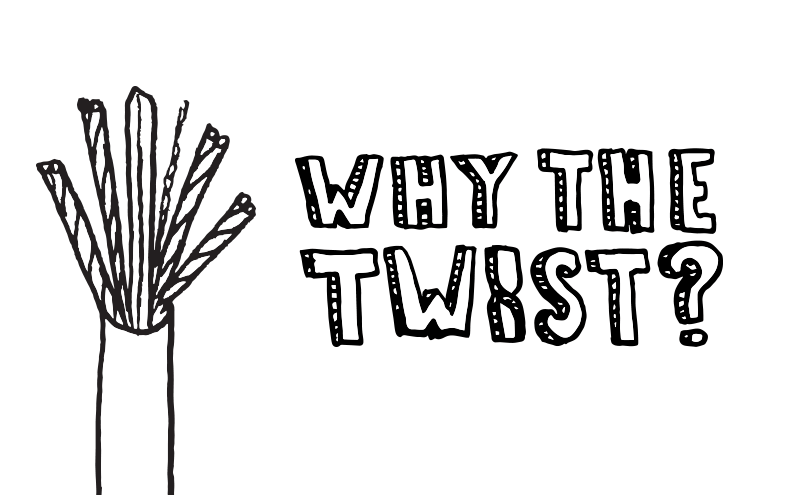Payment methods accepted

Why Are Wires Twisted Inside an Ethernet Cable?
Written by Don Schultz, trueCABLE Senior Technical Advisor, Fluke Networks Copper/Fiber CCTT, BICSI INST1, INSTC, INSTF Certified
The perennial question that IT people and cabling experts are always asked is: “Why is Ethernet cable twisted inside?” This mystery revolves around how Ethernet cable works, and why it is called balanced twisted pair. Let’s untwist this mystery and find out the truth!
Here is an inside look at our trueCABLE Cat6 Riser unshielded cable:

In the photo, the wire pairs are twisted as such:
Four pairs, twisted into
- Blue solid - white/blue stripe
- Orange solid - white/orange stripe
- Green solid - white/green stripe
- Brown solid - white/brown stripe
Eight total conductors (23 AWG copper thickness each)
Remember that high-school science class you thought you would never use again? Well, never say never!
The primary purpose of the twists is to reduce internal electrical-interference. In effect, Ethernet cable comes with its own built-in “shielding”. Now, wait a minute! You might be thinking that unshielded Ethernet cable has no shielding, and shielded Ethernet cable is the type that has shielding. This is only partially correct. While shielded Ethernet cable, like F/UTP, does provide an overall foil shield, the cable could not function without the “built-in” shielding in the form of twisted pairs. That external, overall foil-shield is to prevent outside electrical (magnetic fields or radio waves) from getting at the inside of your cable. For illustration, imagine yourself enjoying a nice classical orchestra and then a rock band with thousands of screaming fans firing up right next door. Now, seal up your classical orchestra into a sound-resistant dome. That is how an overall foil-shield works, when the cable is “shielded”. For more information about that, see Shielded vs Unshielded Cable.
What about the inside of the cable?
Sticking with our previous illustration, even classical orchestras are a bit loud, and should the orchestra members get confused because other instruments are louder than theirs, then there will be confusion and bad music. The same concept applies to Ethernet. Each wire conductor will generate an unequal electromagnetic-field. That means one conductor can interfere with another. Considering gigabit Ethernet makes use of all eight conductors, then this would end up a horrible mess if all the conductors started “talking” to each other. This is called cross-talk and it is when the conductors pass electrons back and forth.
While you cannot actually see magnetic fields (and if you can see a doctor immediately), trust me they are there. For every extension cord or anything that carries electrons through it, there will be a magnetic field enveloping it to some degree. The lower the voltage, the smaller the magnetic field. Ethernet cable is very low voltage in nature, but the voltage is still present, and the twists in the conductor pairs protect the cable from itself.
The twists reverse the polarity of the conductors at each and every twist, and this cancels out differences in their individual electromagnetic fields. The result is electromagnetic balance, and why Ethernet cable is called balanced twisted pair. We have, in effect, harmony. The pair is far “quieter”, like a library. Now we can talk to each other and actually make sense of the conversation.
But wait, there is more!
The astute observer will notice that different pairs have different twist rates. This means more twists per inch on some pairs, and less on others. This is by design, and not a defect. Now that one pair is working in harmony at a certain twist rate, it will be susceptible to potential interference with another harmonious pair at the same twist rate. The solution is to vary the twist rates between the pairs that are next to each other inside the cable.
Colors. Why are the pairs all different colors?
This is a great question. Now that we have gone through a great deal of trouble to twist the conductor pairs properly, it would make zero sense to undo all of that wonderful harmony at the end you hook up (terminate). The colors are for humans...electrons don’t care about color. This blog article, T568a vs T568b, Which to Use, describes how to keep things harmonious by putting the conductors into the proper sequence.
So, now you probably wish you paid a bit more attention in that high school science class (wink)? The subject of electromagnetic fields, and how electricity works, can become complicated quickly. Happy Networking!
trueCABLE presents the information on our website, including the “Cable Academy” blog and live chat support, as a service to our customers and other visitors to our website subject to our website terms and conditions. While the information on this website is about data networking and electrical issues, it is not professional advice and any reliance on such material is at your own risk.




























How to use pvc bend 1 inch maximum for cable pulling please send me complete information.
Hey Muhammad! Thanks for reaching out to us. Could you please elaborate on your question further?
I have tried all the different twisting pitch but still cable fails in next… kindly help me..
Hey Vishal,
It’s hard to be definitive without knowing more about your network, but causes of these failures can often be found at the point of termination. In fact, untwisting the conductors more than absolutely necessary during termination is a common source for NEXT failures.